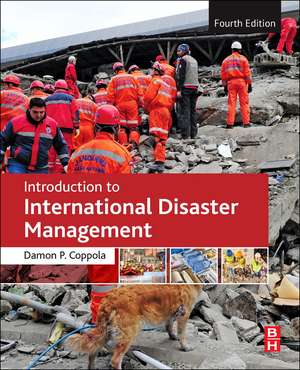Introduction to International Disaster Management
Autor Damon Coppolaen Limba Engleză Paperback – 15 feb 2021
Taking a real-world approach with considerable illustration through case studies and recent and historical disaster events, this book prepares students interested in joining the disaster management community to understand the work they will be doing. In addition, it assists those who already work with the disaster management community by helping them better navigate this complex environment.
- Includes sections on the Ebola epidemic, the Nepal Earthquake, the 2015/2016 Western U.S. Wildfires, the Indonesia Palm Oil Fires, Hurricanes Harvey, Irma and Maria, the Mexico City Earthquake, emerging hazards like trash avalanches, and more
- Provides a valuable introduction on the groundbreaking Sendai Framework for Disaster Risk Reduction (2015-2030) signed in March of 2015, along with an explanation of the relationship of this effort to Sustainable Development Goals and the Paris Agreement
- Explores the importance of global disaster risk reduction
- Covers key terms and chapter summaries, as well as instructor resources, support learning and instruction
| Toate formatele și edițiile | Preț | Express |
|---|---|---|
| Paperback (2) | 345.17 lei 36-50 zile | +77.21 lei 6-12 zile |
| ELSEVIER SCIENCE – 15 feb 2021 | 502.94 lei 15-29 zile | +77.21 lei 6-12 zile |
| ELSEVIER SCIENCE – 18 aug 2016 | 345.17 lei 36-50 zile |
Preț: 502.94 lei
Preț vechi: 672.93 lei
-25% Nou
96.27€ • 104.60$ • 80.92£
Carte disponibilă
Livrare economică 24 martie-07 aprilie
Livrare express 15-21 martie pentru 87.20 lei
Specificații
ISBN-10: 0128173688
Pagini: 896
Dimensiuni: 191 x 235 x 41 mm
Greutate: 1.28 kg
Ediția:4
Editura: ELSEVIER SCIENCE
Public țintă
Academic (undergraduate, masters, and Ph.D. granting institutions) and professionals in disaster risk reduction, development, emergency management, and humanitarian affairsCuprins
1. The Management of Disasters
2. Hazards
3. Risk and Vulnerability
4. Mitigation
5. Preparedness
6. Response
7. Recovery
8. Participants: Governmental Disaster Management Agencies
9. Participants: Nongovernmental Organizations, Academia, and the Private Sector
10. Participants: Multilateral Organizations and International Financial Institutions
11. Special Considerations
Descriere
Introduction to International Disaster Management, Fourth Edition, offers an unbiased, global perspective for students and practitioners alike. It provides a comprehensive understanding of the disaster management profession, covering the varied sources of risk and vulnerability, the systems that exist to manage hazard risk, and the many different stakeholders involved, from individuals to global organizations. This text also serves as a reference on scores of disaster management topics, including various technological and intentional hazards, on international disaster management structures and systems, on global humanitarian spending and support, and much more.
Taking a real-world approach with considerable illustration through case studies and recent and historical disaster events, this book prepares students interested in joining the disaster management community to understand the work they will be doing. In addition, it assists those who already work with the disaster management community by helping them better navigate this complex environment.
- Includes sections on the Ebola epidemic, the Nepal Earthquake, the 2015/2016 Western U.S. Wildfires, the Indonesia Palm Oil Fires, Hurricanes Harvey, Irma and Maria, the Mexico City Earthquake, emerging hazards like trash avalanches, and more
- Provides a valuable introduction on the groundbreaking Sendai Framework for Disaster Risk Reduction (2015-2030) signed in March of 2015, along with an explanation of the relationship of this effort to Sustainable Development Goals and the Paris Agreement
- Explores the importance of global disaster risk reduction
- Covers key terms and chapter summaries, as well as instructor resources, support learning and instruction
Recenzii
"Damon Coppola's Introduction to international disaster management is a single volume sourcebook that makes excellent use of full colour graphics and has numerous inset boxes highlighting aspects of the topics under discussion. The book follows a logical progression starting with the history of disasters and ending with details of disaster management agencies (governments, NGOs, multilateral organisations), where they are located within national government structures, and what they do. The bulk of the book is given over to consideration of hazards, risks and vulnerability, and the four stages of traditional disaster management namely: mitigation, preparedness, response, and recovery. A final chapter deals briefly with special considerations in relation to disasters covering such diverse topics as the media, political will, donor fatigue, state sovereignty, climate change, terrorism, and pandemics. This book is an excellent starting point for the study of disaster planning providing both global perspective and local detail." --Colin Perry, The Brunei Times
"Disaster management is a discipline and a profession that is growing and evolving rapidly; and international disaster management is a subdiscipline. This text is intended as a guide and reference for students and practitioners involved at any level. The specifics of all facets of mitigation, preparedness, response, and recovery are covered clearly and in detail, beginning with general background and proceeding to the various types of hazards, assessment of vulnerability and risk (and disparities among countries), forms of structural and nonstructural mitigation, the practicalities of preparedness (communications, training, animal care, public warning), the complexities of international response, and the recovery period. Three chapters discuss the players: government agencies, nongovernmental organizations, and multilateral and international financial institutions. The concluding chapter covers special issues (sovereignty, distribution of relief, emerging epidemics, among other topics). Coppola is a well-seasoned practitioner and works now as a systems engineer with a disaster management consulting firm." --SciTechBookNews
"This monograph provides practitioners, educators and students with a comprehensive overview of the players, processes and special issues involved in the management of large-scale natural and technological disasters. The book discusses special issues encountered in the management of international disasters, and explains the various private, non-governmental, national, and international agencies that assist in preparedness, mitigation, response and recovery during national and regional events. Concentrating on the four major phases of emergency management – mitigation, preparedness, response, and recovery – the author deals with such timely topics as Hurricane Katrina, the 2004 Asian tsunami, and SARS. It also serves as a reference to governmental and other agencies involved in international disaster management activities." --MCEER Information Service
"Updated to reflect the latest data in global disaster trends, this second edition offers a comprehensive overview of the complex issues surrounding preparedness, response and relief during international disasters. It will be a useful reference for students, practitioners and anyone interested in international humanitarian response and recovery." --Foreign Service Journal




